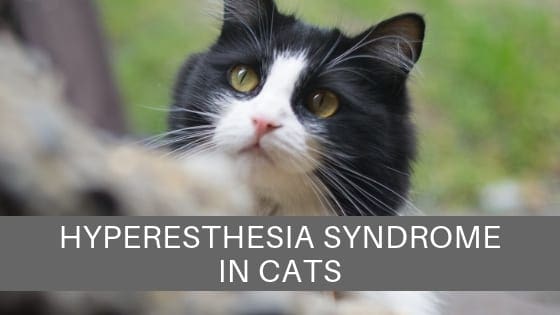
This is also referred to as rolling skin disease, and in fact, the skin does ripple and twitch. It’s a condition that typically affects younger cats. The cause of hyperesthesia syndrome is unknown but some experts describe it as a neurotransmitter malfunction in the brain during periods of anxiety. It’s also believed by some to be connected to obsessive compulsive behavior. It’s not a common disorder but if your cat is experiencing this, it’s a very frightening experience for everyone in the home.
Hyperesthesia causes the cat to feel intensely sensitive to being touched. The parts of the body most vulnerable are the spine and along the tail.
Signs of Hyperesthesia Syndrome
With hyperesthesia you’ll usually notice the cat engages in an excessive amount of self-grooming. Typically, the area the cat focuses on will be the spine and tail. It can sometimes continue to the point of hair chewing and self-mutilation. Other physical signs include tail lashing and skin twitching or rippling. Often, the cat will exhibit sudden bursts of activity and this can escalate into aggressive behavior. The cat may attack other pets in the home or even display aggression toward human family members. The cat may appear perfectly fine and then react aggressively as if a switch has been flipped. The cat even display seizure-like behavior.
In addition to the behaviors mentioned above, other signs may include dilated pupils, biting at the tail and an increase in vocalization.
Cats most at risk are usually those living in ongoing stressful environments.
Treating Hyperesthesia Syndrome
When diagnosing hyperesthesia other underlying conditions must be ruled out first, such as epilepsy, arthritis, abscesses, cancer, spinal problems, injuries, parasites, and other skin conditions. There are so many conditions that can result in hyperesthesia-like behaviors so it’s important to go through the list to exclude other possible causes.
Hyperesthesia is usually controlled by the administration of anti-anxiety and/or anti-seizure or antidepressant medication, and pain medication. The type of medication prescribed will depend on whether the disorder is due to nerve pain or OCD. Environmental factors must also be addressed as well by reducing the cat’s exposure to anxiety triggers. Increase positive stimulation and provide a more enriching environment in the form of interactive playtime, puzzle feeders ,and increased vertical territory. Make sure the cat has safe places to retreat to as well to help control stress exposure. If your cat does suffer from hyperesthesia syndrome, limit introducing future stress as well. Don’t bring in other pets, make abrupt changes in the home or in the cat’s daily schedule.
Hyperesthesia can’t be cured but it certainly can be controlled through proper diagnosis, medical treatment, and environmental enrichment. In-between episodes, the cat will go back to completely normal behavior.
Need More Information?
If you suspect that your cat is displaying behavior that resembles hyperesthesia, contact your veterinarian. Any change in your cat’s normal behavior should be viewed as a potential red flag that something might be wrong and needs veterinary attention.
For more information on environmental enrichment, interactive playtime, training and stress reduction for cats, refer to the books by Pam Johnson-Bennett. Pam’s books are available at bookstores and also online. We’ve included links to Amazon here on our website.
BUY PAM’S BOOKS
If you have a question regarding your cat’s behavior or health, please contact your veterinarian. This article is not intended as a replacement for your cat’s veterinary care. This article is for information purposes only and not offering medical advice or providing a medical diagnosis.

